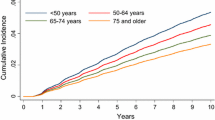Abstract
Objective: Cancer is more likely to be diagnosed in the left breast than the right, but the reasons are undetermined. Left-sided predominance has not been evaluated for some demographic groups or by tumor location.
Methods: Laterality was analyzed among 419,935 incident unilateral breast cancers from 26 population-based cancer registries covering 40% of the US population. Logistic regression assessed the independent contribution of race, ethnicity, age, histology, stage, and location to laterality.
Results: Breast cancer was about 5% more likely to be diagnosed in the left breast than the right, a finding that was generally consistent across demographic groups and tumor types. Left-sided predominance was evident among both younger (<45 years) and older women, and among men with either in situ or invasive disease. Among women, tumors in the upper-outer quadrant, where one-third of cancers are located, occurred with equal frequency in the left and right breast, while those in the lower quadrants were about 10% more likely to occur in the left breast.
Conclusion: The observation that the left breast is at greater risk of cancer than the right may not apply to tumors arising in the upper-outer quadrant. The identification of physiologic, pathologic, or immunologic differences between the lower, but not upper, left and right breasts may assist in explaining breast cancer laterality.
Similar content being viewed by others
References
Garfinkel L, Craig L, Seidman H (1959) An appraisal of left and right breast cancer. J Natl Cancer Inst 23: 617–631.
Blot W, Fraumeni J, Young J (1977) Left-sided breast cancer. Lancet 2: 762–763.
Senie RT, Rosen PP, Lesser ML, Snyder RE, Schottenfeld D, Duthie K (1980) Epidemiology of breast carcinoma II: factors related to the predominance of left-sided disease. Cancer 46: 1705–1713.
Tulinius H, Bjarnason O, Sigvaldason H, Bjarnadottir, Olafsdottir G (1988) Tumors in Iceland: 10. Malignant tumours of the breast. A histological classification, laterality, survival and epidemiological considerations. Acta Path Microbiol Immunol Scand 96: 229–238.
Ekbom A, Adami HO, Trichopoulos D, Lambe M, Hsieh CC, Ponten J (1994) Epidemiologic correlates of breast cancer laterality (Sweden). Cancer Causes Control 5: 510–516.
Weiss HA, Devesa SS, Brinton L (1996) Laterality of breast cancer in the United States. Cancer Causes Control 7: 539–543.
Kamby C, Andersen J, Ejlertsen B, Birkler NE, Rytter L, Zedeler K, Rose C (1991) Pattern of spread and progression in relation to the characteristics of the primary tumour in human breast cancer. Acta Oncol 30: 301–308.
Segi M, Fukushima I, Fujisaku S, et al. (1957) An epidemiological study of cancer in Japan. Gann 48: 1–48.
Ing R, Ho JHC, Petrakis NI (1977) Unilateral breast-feeding and breast cancer. Lancet 2: 124–127.
Senie RT, Saftlas AF, Brinton LA, Hoover RN (1993) Is breast size a predictor of breast cancer risk or the laterality of the tumor? Cancer Causes Control 4: 203–208.
Thurfjell E, Hsieh CC, Lipworth L, Ekbom A, Adami HO, Trichopoulos D (1996) Breast size and mammographic pattern in relation to breast cancer risk. Eur J CancerPrev 5: 37–41.
Trichopoulos D, Lipman RD (1992) Mammary gland mass and breast cancer risk. Epidemiol 3: 523–526.
Hartveit F (1983) The side and size of breast tumors. Clin Oncol 9: 135–142.
Titus-Ernstoff L, Newcomb PA, Egan KM, Baron JA, Greenberg ER, Trichopoulos D, Willett WC, Stampfer MJ (2000) Lefthandedness in relation to breast cancer risk in postmenopausal women. Epidemiol 11: 181–184.
Howe HL, Chen VW, Hotes J, Wu XC, Correa C, Fulton JP, eds. Cancer in North America, 1994-1998, Vol. 1, Incidence. Spring-field, IL: North American Association of Central Cancer Registries, April 2001.
Hulstrom D, ed. Standards for Cancer Registries Vol. II: Data Standards and Data Dictionary, 7th edn, Version 10. Springfield, IL: North American Association of Central cancer Registries, March 2002.
Percy C, Van Holten V, Muir C (1990) International Classification of Diseases for Oncology, 2 edn. Geneva: World Health Organization.
Larsen RJ and Marx ML (1986) An introduction to mathematical statistics and its applications, 2nd edn. Prentice-Hall, Englewood Cliffs, NJ.
Wilcosky TC, Chambless LE (1985) A comparison of direct adjustment and regression adjustment of epidemiologic measures. J Chron Dis 38: 849–856.
20. SEER 11 registry public use file in SEER-Stat (Nov 2001).
Author information
Authors and Affiliations
Corresponding author
Rights and permissions
About this article
Cite this article
Perkins, C.I., Hotes, J., Kohler, B.A. et al. Association between Breast Cancer Laterality and Tumor Location, United States, 1994–1998. Cancer Causes Control 15, 637–645 (2004). https://doi.org/10.1023/B:CACO.0000036171.44162.5f
Issue Date:
DOI: https://doi.org/10.1023/B:CACO.0000036171.44162.5f




